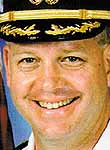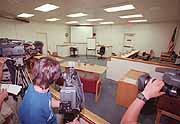 Japan still pushing for salvage of Ehime Maru Japan still pushing for salvage of Ehime Maru
 Rumsfeld prepares order to limit civilian participation Rumsfeld prepares order to limit civilian participation
 A Tribute to the Missing A Tribute to the Missing
 Previous stories Previous stories
Associated Press
WASHINGTON — The captain of a U.S. submarine that collided with and sank a Japanese fishing vessel two weeks ago told Navy investigators he was aware of sonar soundings indicating that a ship was in the vicinity before the accident, a newspaper reported.
 |
| Submarine skipper Cmdr. Scott Waddle reportedly told investigators he did not see a ship when he looked through the periscope before the ascent. |
But the sub's skipper, Cmdr. Scott Waddle, maintained that when he looked for a ship through his periscope before ordering a rapid ascent to the surface, he didn't see anything and was not warned of any danger by a sailor whose job it was to plot positions of nearby ships, The Washington Post said in today's editions.
The Washington Times, meanwhile, said a confidential Navy report outlines a series of errors made by the crew of the USS Greeneville, stating that the periscope sweep was too brief and not high enough to detect the Japanese vessel. The report also blamed the presence of civilians inside the sub's control room for disrupting communications between Waddle and a technician tracking the fishing vessel in busy waters near Pearl Harbor.
A less crowded area around the periscope "could have dramatically improved this situation,'' the Times quoted the report as saying. The newspaper said excerpts of the report were read to it yesterday by a Navy source.
The Greeneville, a nuclear-powered attack submarine, had 16 civilians aboard when it collided with the fishing vessel Ehime Maru on Feb. 9. The Japanese boat, on a cruise to teach commercial fishing to high school students, sank, and nine people were lost at sea. Two civilians were at control positions aboard the Greeneville at the time as the sub made an emergency-surfacing training maneuver from 400 feet depth, although the Navy says the civilians did not cause the accident.
The Times said the report of a preliminary investigation conducted by Rear Adm. Charles Griffiths Jr. said his findings "suggest a significant departure from the expected level of professionalism and performance of the ship's key watchstanders and senior leadership'' just before the accident.
The report said there were a "significant number'' of crew and guests pushed together on the periscope stand when Waddle and the officer of the deck, Lt. j.g. Michael J. Coen, were trying to locate the ship associated with the sonar readings.
 |
| News cameras were allowed yesterday to take pictures of the room where the Navy's court of inquiry into the Greeneville accident will begin March 5. Cameras will not be allowed during the proceedings.
Gregory Yamamoto • The Honolulu Advertiser |
"The location and number of civilian visitors did interfere with the ability of the OOD (officer of the deck) and commanding officer to use the fire-control system and converse with the (technician) in ascertaining the contact picture from the time the ship was preparing for periscope depth until the (rapid ascent) was conducted,'' the Times quoted the report as saying.
The Post, quoting an unidentified person close to the investigation, said Waddle told investigators he checked the compass bearings of the nearby ship indicated by sonar readings. He then increased the periscope's magnification and ordered his sub to ascend two feet closer to the surface so he could peer over the waves, but he still didn't see anything.
A sailor in the sub's control room had calculated that the Greenville and the Japanese ship were only 2,000 yards apart, but concluded that he must have been mistaken because the captain had just pronounced the area clear, the Post said. The sailor then arbitrarily plotted the position of the Japanese vessel as 9,000 yards away from the Greenville, the Post said.
Shortly after the accident, the Navy stopped allowing civilians in the control rooms of submarines.
The possibility that the presence of civilians aboard the sub could have contributed to the accident is one of the subjects to be examined in a formal Navy court of inquiry scheduled to convene in Hawaii next month.
The inquiry also will seek to determine whether the Greeneville undertook the emergency-surfacing drill only as a demonstration for the civilians aboard, officials said.
One member of the Greeneville crew told National Transportation Safety Board investigators in Hawaii that the presence of civilians in the control room distracted him from completing his normal work.
The fire control technician was not operating the sonar but was responsible for feeding sonar contact data into an electronic digital display that is available to the sub's captain and control room officers. He also plots sonar contacts on paper as a backup to the electronic system, and it was this backup activity which he told NTSB investigators he did not complete because of congestion in the control room.
The Navy court of inquiry was to have convened Monday in Pearl Harbor. At the request of attorneys for Waddle, it was postponed yesterday until March 5. In the meantime Waddle has been relieved of command.
[back to top] |


